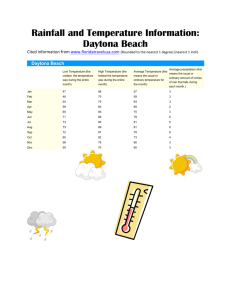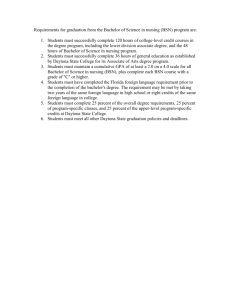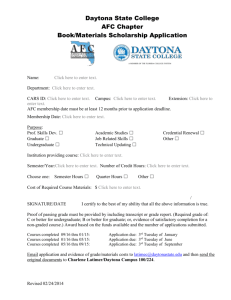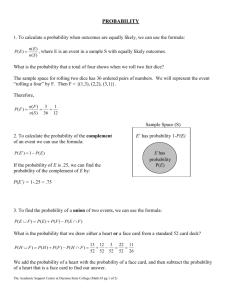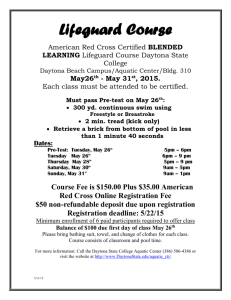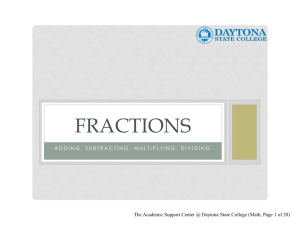Daytona International Speedway Timeline August 16, 1954: Bill
advertisement
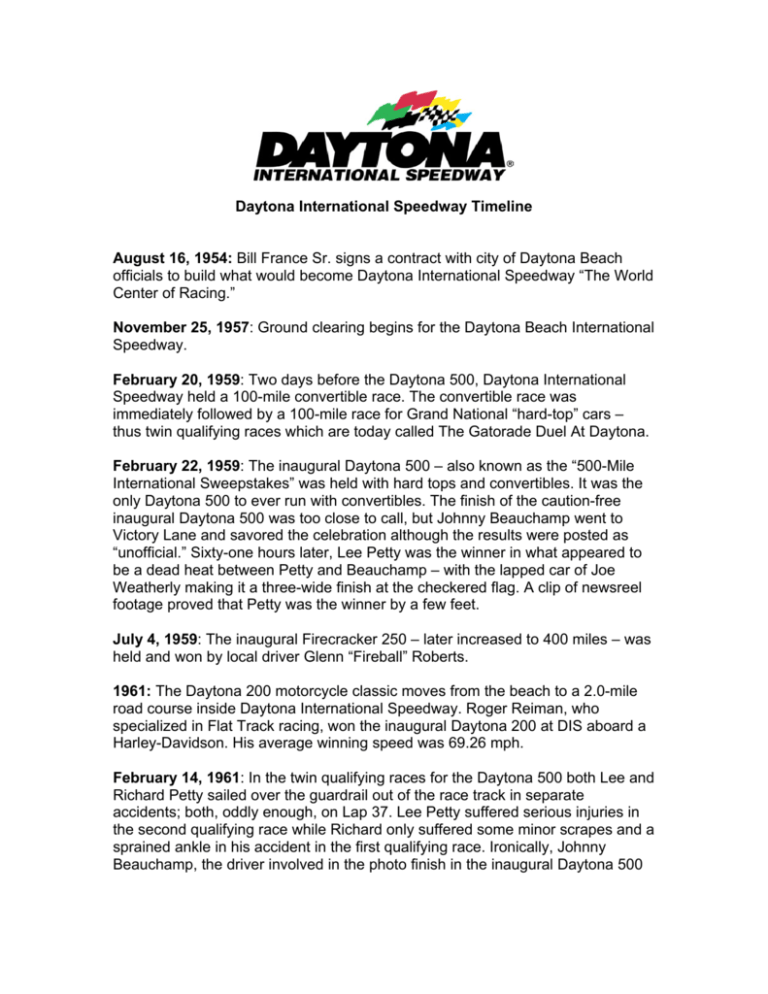
Daytona International Speedway Timeline August 16, 1954: Bill France Sr. signs a contract with city of Daytona Beach officials to build what would become Daytona International Speedway “The World Center of Racing.” November 25, 1957: Ground clearing begins for the Daytona Beach International Speedway. February 20, 1959: Two days before the Daytona 500, Daytona International Speedway held a 100-mile convertible race. The convertible race was immediately followed by a 100-mile race for Grand National “hard-top” cars – thus twin qualifying races which are today called The Gatorade Duel At Daytona. February 22, 1959: The inaugural Daytona 500 – also known as the “500-Mile International Sweepstakes” was held with hard tops and convertibles. It was the only Daytona 500 to ever run with convertibles. The finish of the caution-free inaugural Daytona 500 was too close to call, but Johnny Beauchamp went to Victory Lane and savored the celebration although the results were posted as “unofficial.” Sixty-one hours later, Lee Petty was the winner in what appeared to be a dead heat between Petty and Beauchamp – with the lapped car of Joe Weatherly making it a three-wide finish at the checkered flag. A clip of newsreel footage proved that Petty was the winner by a few feet. July 4, 1959: The inaugural Firecracker 250 – later increased to 400 miles – was held and won by local driver Glenn “Fireball” Roberts. 1961: The Daytona 200 motorcycle classic moves from the beach to a 2.0-mile road course inside Daytona International Speedway. Roger Reiman, who specialized in Flat Track racing, won the inaugural Daytona 200 at DIS aboard a Harley-Davidson. His average winning speed was 69.26 mph. February 14, 1961: In the twin qualifying races for the Daytona 500 both Lee and Richard Petty sailed over the guardrail out of the race track in separate accidents; both, oddly enough, on Lap 37. Lee Petty suffered serious injuries in the second qualifying race while Richard only suffered some minor scrapes and a sprained ankle in his accident in the first qualifying race. Ironically, Johnny Beauchamp, the driver involved in the photo finish in the inaugural Daytona 500 in 1959, was part of the Lee Petty accident and, he too, went over the wall sustaining minor injuries. February 26, 1961: Marvin Panch won the Daytona 500 with an average speed of 149.601 mph for the entire 500 miles, a speed faster than the pole-winning speed of that year’s Indianapolis 500. August 27, 1961: Art Malone drove Bob Osecki’s Hemi-powered, highly modified Indy car named the “Mad Dog IV” to a new world closed-course record speed of 181.561 mph. February 11, 1962: The inaugural Daytona Continental, now known as the Rolex 24, was held as a three-hour race run counter-clockwise on the 3.81-mile road course. Dan Gurney, driving the No. 96 Lotus-Climax 19b S 2500 car, won the Daytona Continental completing 82 laps and averaging 104.101 mph in what was the fastest sports car race ever run in the United States. February 18, 1962: One of NASCAR’s popular drivers Glenn “Fireball” Roberts finally wins a major event in his hometown when he captured his first and only Daytona 500 victory in the No. 22 Pontiac. Roberts earned the pole, won one of the qualifiers and captured the American Challenge invitational for 1961 winners. February 8, 1964: Nelson Stacy wins the inaugural 250-mile Automobile Racing Club of America (ARCA) race at “The World Center of Racing” during Speedweeks. This marked the first superspeedway event in the division’s history. A day earlier, Earl Balmer and Jack Bowsher were winners of the 50-mile qualifying races. February 16, 1964: The Daytona Continental expands to 2,000 kilometers (1,243 miles). With a race time of 12 hours, 40 minutes, the Daytona Continental became the longest endurance race in the United States and was won by Pedro Rodriguez and Phil Hill in the No. 30 Ferrari 250 GTO 64. March 1964: The Daytona 200 motorcycle race finally moves onto the high banks using the full 3.81-mile road course. February 14, 1965: The Daytona 500 is cut short for the first time in history because of rain. Fred Lorenzen, nicknamed “The Golden Boy,” turned 133 of the 200 laps to win the Daytona 500. February 5-6, 1966: The Daytona Continental expands to 24 hours becoming America’s first accredited 24-hour international sports car race and one of the world’s top three endurance races. Ken Miles and Lloyd Ruby won the 24-hour Daytona Continental in the No. 98 Ford Mk II. February 16, 1967: Mario Andretti wins his first and only Daytona 500 in a Holman-Moody Ford, becoming the first open-wheel Indy driver to accomplish the feat. February 1969: The Daytona 500 qualifying races are extended from 100 miles to 125 miles. David Pearson and Bobby Isaac claimed victories. February 20, 1972: A.J. Foyt wins his first and only Daytona 500 by more than two laps in a dominating Wood Brothers Racing car. Actor James Garner serves as the Grand Marshal. Late 1973 The 1974 running of the Daytona 24 Hours is canceled due to an international gasoline crisis. February 14, 1974: Mark Donohue won the inaugural IROC (International Race of Champions) event at Daytona. Competing in a six-driver, 25-lap race on the 3.81-mile road course in Porsche Carrera RSR cars, Donohue battled George Follmer for most of the race as he became the inaugural IROC champion. February 15, 1974: The NASCAR Modified Division came to Daytona International Speedway for the first time. The low-slung, ultra-fast machines used both the high banks and the infield road course. This race drew special interest as Hollywood idol Paul Newman was among the competitors. Bobby Allison won the race. Newman got spun out early in the event by Jack Duffy won was driving the last pre World War II coupe to compete at Daytona. July 4, 1974: David Pearson wins a record third straight Firecracker 400. On the last lap, Pearson was leading Richard Petty when he suddenly backed off the throttle and ducked to the low side of the track on the straightaway entering Turn 1. Petty had to take evasive action and pass him. Pearson gained enough steam and made up the two-second deficit and pulled off sling shot pass in Turn 4. Petty, who had yet to win a 400 at the time and finished second for the fourth straight year, was furious about Pearson’s last lap tricks. January 31 – February 1, 1976: Peter Gregg, driving with Brian Redman in the No. 59 BMW, claims his third consecutive Daytona 24 Hour victory. February 15, 1976: David Pearson and Richard Petty crash battling for the lead coming out of Turn 4 on the last lap of the Daytona 500. When both cars came to a rest they had still not crossed the start/finish line. Petty’s car wouldn’t start but Pearson dumped the clutch and kept the car in neutral to slowly cross the start/finish line to capture the only Daytona 500 victory of his career. The finish was the slowest under green flag conditions in Daytona 500 history. February 20, 1977: Janet Guthrie becomes the first woman driver to compete in the Daytona 500. She finished 12th. August, 1978: Daytona International Speedway is repaved for the first time in its history. The project took several months to complete and was finished in time for the 1979 Daytona 500. February 11, 1979: The inaugural Busch Clash, now known as the Budweiser Shootout, is held as a 20-lap, 50-mile sprint. Buddy Baker won the non-points race that featured the previous season’s pole winners. February 18, 1979: The Daytona 500 is televised live for the first time in event history by CBS Sports. On the final lap, Cale Yarborough and Donnie Allison crashed in Turn 3 while battling for the lead. Richard Petty holds off Darrell Waltrip to win his sixth Daytona 500 while Yarborough and Allison began a heated debate that turned into a fist fight with Allison’s brother Bobby jumping into the fray. February 13, 1982: The inaugural event of NASCAR’s new Busch Series (formerly the NASCAR Sportsman Division) was held with Dale Earnhardt coming home the series’ first winner. February 12, 1984: Cale Yarborough earned the Daytona 500 pole with a record speed of 201.848 mph, the first time a car has qualified at DIS at more than 200 mph. Yarborough would have made the record the previous year but flipped and crashed his car on his second qualifying lap making his speed unofficial. The 1984 Daytona 500 pole win was Cale Yarborough’s record fourth pole. March 1984: Kenny Roberts has announced his retirement and made his 12th and final start at DIS. He began the race as defending champion, and finished a winner again, setting a record race speed of 113.14 mph. July 4, 1984: President Ronald Reagan served as Grand Marshal for the Pepsi Firecracker 400 and gave the starting command “Gentlemen, start your engines” aboard Air Force One. Reagan arrived mid-race, called the race with MRN Radio’s Ned Jarrett and witnessed Richard Petty’s historic 200th NASCAR win. It was the first time in NASCAR history that a sitting President attended a race. February 9, 1987: Dawsonville, Ga., driver Bill Elliott sets the Daytona 500 qualifying record with a speed of 210.364 mph. February 14, 1988: The first restrictor-plate Daytona 500 race is held at Daytona International Speedway. Bobby Allison held off his son Davey to win his third Daytona 500 in the race’s only father-son finish. Allison also became the oldest Daytona 500 winner at the age of 50 years, two months, 11 days. February 2 -3, 1991: Hurley Haywood wins his record fifth Daytona 24 Hour. Haywood, along with Frank Jelinski, Henri Pescarlo, Bob Wollek and John Winter drove the No. 7 Porsche 962C. July 4, 1992: President George Bush served as the Grand Marshal for the Pepsi 400. He gave the starting command for Richard Petty’s final NASCAR race at Daytona International Speedway. July 5, 1996: The Daytona 500 Experience, the award-winning motorsports attraction formally known as DAYTONA USA, opened and transformed Daytona International Speedway into a destination for tourists visiting the Daytona Beach area. July 5, 1997: John Andretti, driving Cale Yarborough’s No. 98 Ford, becomes the last driver to win the Pepsi 400 during the daytime. February 7, 1998: Dale Earnhardt becomes the first driver to tackle the 2.5-mile high-banked tri-oval under the newly-installed lighting system in a special 20-lap test following Daytona 500 qualifying. February 8, 1998: The Busch Clash is renamed the Bud Shootout and took on a new format – two 25-lap races with the Bud Shootout qualifying race featuring the previous season’s fastest second-round qualifiers and the main Bud Shootout. One two-tire pit stop was required for each race. February 15, 1998: On his 20th attempt, Dale Earnhardt finally earned his first and only victory in the 40th annual Daytona 500. March 1998: Scott Russell of Conyers, Ga., nicknamed “Mr. Daytona,” wins his fifth and final Daytona 200 By Honda aboard a Yamaha. October 17, 1998: Jeff Gordon won the first ever Pepsi 400 run under the lights at Daytona. The Pepsi 400 was delayed until October because of the summer wildfires. February 14, 1999: Supreme Court Associate Justice Clarence Thomas serves as Grand Marshal and gives the starting command “Gentlemen, start your engines” for the Daytona 500. February 18, 2000: The inaugural NASCAR Craftsman Truck Series race is held at Daytona with Mike Wallace capturing the 250-mile race. July 1, 2000: George W. Bush, Governor of Texas and Presidential Candidate, served as the Grand Marshal for the Pepsi 400. February 3-4, 2001: Dale Earnhardt along with Andy Pilgrim, Kelly Collins and his son, Dale Earnhardt Jr., drove the No. 3 Chevrolet Corvette C5-R in the Rolex 24. They finished fourth overall and second in the GTS class. February 11, 2001: The Bud Shootout was renamed the Budweiser Shootout and was lengthened to 70 laps. The Bud Shootout Qualifier was discontinued as qualifying for Cup races was reduced to one round. February 18, 2001: On his 463rd career Cup start, Michael Waltrip holds off teammate Dale Earnhardt Jr. to win the Daytona 500, his first career victory. His owner Dale Earnhardt dies in a last-lap crash in Turn 4. July 7, 2001: Dale Earnhardt Jr. wins the Pepsi 400, his first career DIS victory and 11 years to the day that his father won his first then-Winston Cup race at DIS. February 2002: Daytona International Speedway honors its winningest driver Dale Earnhardt with a statue located outside DAYTONA USA, now known as The Daytona 500 Experience. 2003: The Budweiser Shootout was broken into two segments. The first segment is 20 laps long followed by a 10-minute intermission. The race concluded with a 50-lap second segment. February 13, 2004: NASCAR Craftsman Truck Series season opener is held under the lights for the first time with Roush Racing’s Carl Edwards winning the race. February 15, 2004: President George W. Bush serves as Grand Marshal for the Daytona 500 and Dale Earnhardt Jr. wins “The Great American Race” on his fifth attempt. The race was also the first for new sponsor Nextel. July 6, 2004: Benny Parsons, the 1975 Daytona 500 champion, kicks off the multi-million infield renovation by tearing down the Cup garages. The massive renovation included a new Turn 1 tunnel, new garages, the four-story Daytona 500 Club and Gatorade Victory Lane, the one-of-a-kind Sprint FANZONE and waterfront specialty vehicle parking. February 17, 2005: The qualifying races for the Daytona 500, which feature every Daytona 500 entrant and determine the starting lineup for “The Great American Race,” carried a new name and distance -- the Gatorade Duel at Daytona. The 150-mile qualifying races, which had traditionally been two 125mile qualifying races, were won by Michael Waltrip and Tony Stewart. March, 12, 2005: Canadian Miguel Duhamel won his record fifth Daytona 200 By Honda. Duhamel, riding for factory Honda, tied Scott Russell atop the all-time Daytona 200 wins list with five triumphs in the prestigious motorcycle classic. March, 10, 2006: Ricky Carmichael, aboard the No. 4 Team Makita Suzuki RMZ450, wins his record fifth Daytona Supercross By Honda, snapping a tie with Jeff Stanton. July 6, 2006: Vice President of the United States Dick Cheney attends the Pepsi 400. Cheney led the crowd in the Pledge of Allegiance then viewed the race from the Daytona 500 Club. For the second straight year, Tony Stewart wins the midsummer classic and scales the fences to the top of the flag stand. 2006: The Daytona 500 Experience, formally DAYTONA USA, celebrates its 10year anniversary. As part of the celebration, the attraction adds the new Daytona 500 Champion’s Walk of Fame, which is located just outside the attraction and honors…. February 8, 2007: Bobby Gerhart wins a record fifth ARCA 200. His previous wins were 1999, 2002, 2005 and 2006. February 18, 2007: Kevin Harvick nips Mark Martin at the start/finish line to capture the closest Daytona 500 finish since the advent of computer scoring in 1993 with a margin of victory of .020 seconds. This finish was also the eighth closest in the NASCAR Sprint Cup Series history. July 1, 2007: DAYTONA USA officially became The DAYTONA 500 EXPERIENCE. The name was changed to align the “Official Attraction of NASCAR” with the most prestigious race in NASCAR – The Daytona 500. July 5, 2007: At the Infield Media Center, 22 of the 24 living Daytona 500 champions gathered for a historic media event to promote the 50th running of "The Great American Race" on Sunday, February 17, 2008. July 7, 2007: The NASCAR Nationwide Series race was postponed by rain the previous night and was held Saturday morning. The postponement created the first-ever doubleheader as DIS with the 400-mile Sprint Cup Series race scheduled for Saturday night. Kyle Busch captured the Winn-Dixie 250 but Jamie McMurray nosed Busch out for the 400-mile race victory by a margin of victory of .005 seconds, the second-closest Sprint Cup Series finish in history since the advent of computer scoring. Feb. 17, 2008: Daytona International Speedway hosts the historic 50th running of the Daytona 500 NASCAR Sprint Cup Series race. A sell-out crowd witnessed Ryan Newman make a last-lap pass of Tony Stewart to win the most anticipated event in racing history. The victory was the first Daytona 500 triumph for both Newman and his car owner Roger Penske. The living champions of the Daytona 500 served as Grand Marshals, seven-time Daytona 500 winner Richard Petty was the Honorary Starter, the Daytona 500 pace car driver was 1960 Daytona 500 winner Junior Johnson, the National Anthem was performed by Trisha Yearwood and the fly-over was done by the USAF Thunderbirds. e
